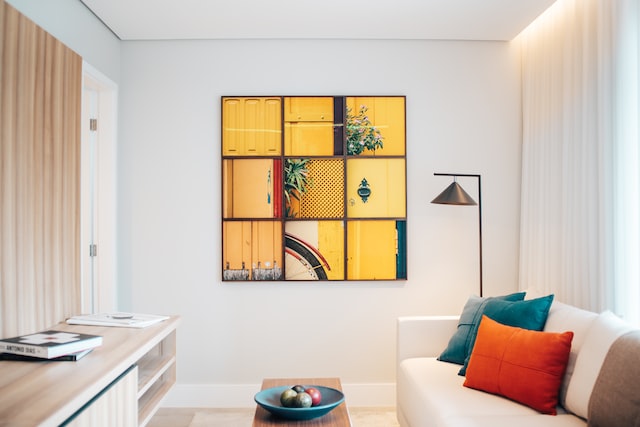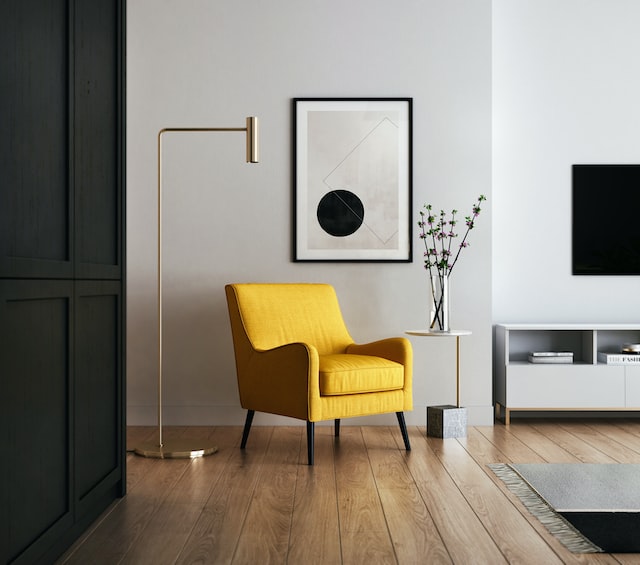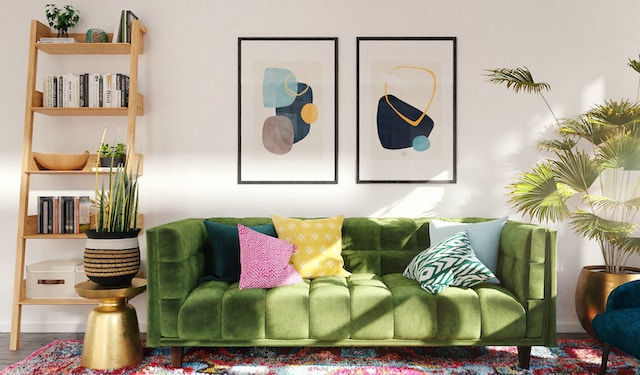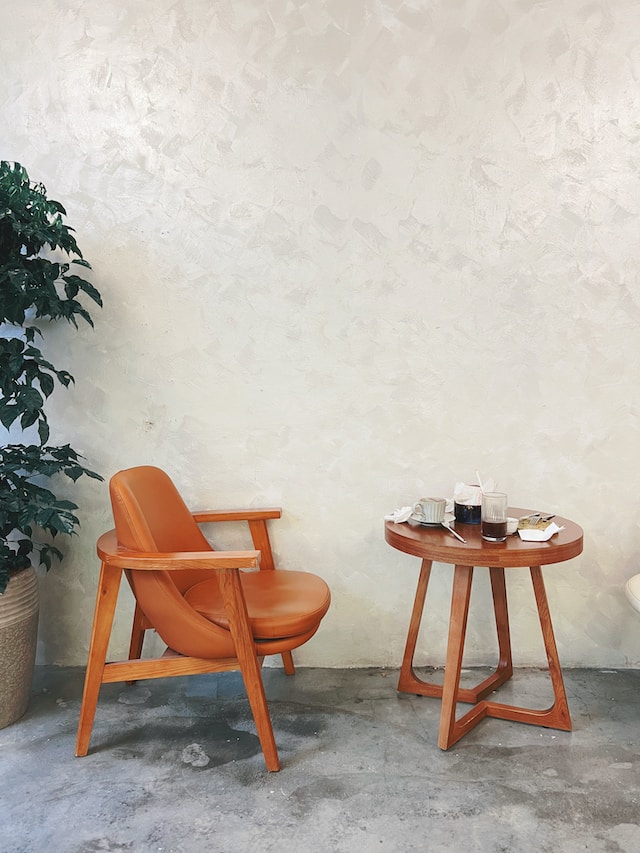
When it comes to decorating small spaces, one of the most important things to consider is color. With the right color palette, you can make even the tiniest of rooms feel larger, more spacious, and more open. But how do you choose the right colors to achieve these effects?
First and foremost, you’ll want to start with light colors. White, cream, light gray, and pastels are all great choices for small spaces because they reflect light and make the room feel brighter and more airy. Using a monochromatic color scheme (all shades of the same color) can also help to create a sense of continuity throughout the room.
But just because you’re using light colors doesn’t mean you can’t add a little bit of depth and interest to the space. Consider incorporating a pop of color in one or two strategic places, like a bright accent wall or a colorful piece of artwork. This will draw the eye and create a sense of contrast that can make the space feel more dynamic.
Another important consideration is the use of texture. While you may be tempted to keep everything smooth and sleek in a small space, adding some texture can actually make the room feel more inviting and cozy. Consider using textured fabrics, like a chunky knit throw or a shag rug, to add some visual interest and warmth to the space.
Finally, consider the use of lighting to enhance the effect of the colors you’ve chosen. Natural light is always best, so try to maximize the amount of sunlight that enters the room. If you don’t have a lot of natural light available, consider using a variety of lighting sources (like floor lamps, table lamps, and overhead lighting) to create a bright, welcoming atmosphere.

Understanding Small Spaces
Small spaces present unique design challenges that must be carefully considered to maximize their true potential. Whether it is a studio apartment, a cozy bedroom or a tiny living room, there are many factors to consider when trying to make a small space appear larger. In this section, we will explore the definition of small spaces and their unique challenges, as well as the factors that influence the perception of space.
Typically, small spaces have areas that are less than 1000 square feet. These spaces can present many challenges, such as limited storage, lack of natural light, and a cramped feeling that can leave the occupants feeling claustrophobic. It can also be challenging to fit in all of the necessary furniture and functional elements into a small space, without making it look overcrowded or cluttered.
Factors Influencing the Perception of Space
There are a variety of factors that can influence how a small space is perceived. Understanding these factors is crucial when trying to design a small space that looks and feels larger.
Lighting
Lighting plays a crucial role in how a space is perceived. Natural light is the best way to make a small space appear larger, so it is important to maximize any available windows. In addition, adding strategic lighting fixtures can also help to create a sense of depth and dimension. This can be achieved through the use of lamps, track lighting or even pendant lights.
Mirrors and Reflective Surfaces
Mirrors and reflective surfaces can be a great way to make a small space appear larger. They reflect light and create the illusion of depth and space. Mirrors can be strategically placed on walls or even on furniture to enhance the effect.
Wall Colors
Choosing the right wall colors can also make a big impact on how a small space is perceived. Lighter, neutral colors tend to make a space feel larger and airier. However, adding pops of color in strategic places can create interest and contrast that can make the space feel more dynamic.

Furniture Arrangement
The way furniture is arranged can make a big difference in how a small space is perceived. It is important to choose furniture that is appropriately sized for the space and arrange it in a way that maximizes functionality without making the space feel cramped. One common technique is to place furniture along the walls to create an open space in the center of the room.
Color Psychology and Perception
When designing a small space, choosing the right color palette is crucial in creating the right atmosphere and perception of the space. The colors you choose can have a significant impact on how the space is perceived and the mood it evokes. In this section, we will explore how colors affect perception, the difference between warm and cool colors, the psychological associations of different colors, and choosing colors based on the desired atmosphere and mood.
How Colors Affect Perception
Colors can create a sense of space, depth, and emotion. Choosing the right color palette can make a small space appear larger or smaller, brighter or darker, energetic or relaxing. For example, lighter colors tend to make a space feel larger and airier, while darker colors can make the space feel smaller and more intimate. Moreover, colors can affect our emotions and mood, making us feel calm, anxious, energized, or happy.
Warm versus Cool Colors
Colors can be divided into two categories: warm and cool. Warm colors such as red, orange, and yellow tend to make a space appear smaller and cozier while also evoking feelings of warmth and energy. On the other hand, cool colors like blue, green, and purple can create a sense of calm and relaxation or a feeling of spaciousness.
Psychological Associations of Different Colors
Colors can also evoke different psychological associations in us. For example, red is often associated with passion, energy, and excitement, while blue is associated with calmness, trust, and reliability. Green is often associated with nature, growth, and balance, while yellow is often associated with happiness, optimism, and cheerfulness. It is important to consider the psychological associations of different colors when choosing a color palette for a small space.
Choosing Colors Based on Desired Atmosphere and Mood
Choosing the right color palette for a small space depends on the desired atmosphere and mood. For example, if you want to create a calm and relaxing atmosphere, you may consider using cool colors like blue and green. However, if you want to create an energetic and vibrant space, warm colors like red and orange may be more appropriate. It is also important to consider the existing lighting in the space and how the chosen colors will be affected by it.
Strategies for Choosing Color Palettes
When it comes to choosing colors for small spaces, it’s important to consider how colors can affect the perceived size of the room, as well as the mood and atmosphere. Let’s explore various strategies for choosing color palettes that can make small spaces appear larger and more inviting.
Light and Neutral Colors
One of the easiest ways to create a sense of spaciousness in a small space is by using light and neutral colors. These colors reflect more light, creating the illusion of a brighter and larger space. White, cream, beige, and light gray are all excellent options. These colors can be used on walls, ceilings, and even furniture to create a cohesive and airy feel to the space. However, it’s important to add texture and depth to keep the space from feeling too sterile.
Monochromatic Color Schemes
A monochromatic color scheme involves using different shades and tints of the same color. For example, a blue monochromatic color scheme may include light blue walls, navy blue furniture, and a turquoise area rug. This approach provides a subtle and cohesive look that can make a small space appear larger. Additionally, a monochromatic color scheme can create a sense of tranquility, making it a great option for small bedrooms or bathrooms.
Pastel Colors
Pastel colors are soft, muted hues that can create a sense of calmness and serenity. These colors include shades of pink, lavender, mint green, and baby blue. Because of their subtle nature, pastel colors can make a small space feel more inviting and cozy. They can be used as wall colors, furniture upholstery, or even as accent pieces.
Accent Colors
Adding accent colors to a predominantly neutral color palette can create visual interest and depth. Accent colors can be added through artwork, throw pillows, or a statement piece of furniture. When using accent colors, it’s important to keep a balanced look by choosing a maximum of one or two colors, and using them sparingly throughout the space.

Tips for Applying Color Palettes in Small Spaces
Choosing the right color palette is crucial when designing a small space. It can make the space appear larger, brighter, and more inviting. In this section, we will provide tips for applying color palettes in small spaces.
- Start with a Neutral Base
When choosing a color palette, it’s best to start with a neutral base. Neutral colors like white, beige, and gray reflect more light, creating a bright and airy feel to the space. This creates a blank canvas for adding pops of color to create visual interest.
- Use Lighter Shades
Using lighter shades of color is important when designing a small space. Lighter shades reflect more light and create the illusion of space. Lighter shades also make a space feel more serene and relaxing.
- Choose One or Two Accent Colors
Adding one or two accent colors can create visual interest and depth to a predominantly neutral palette. Choose warm or cool accent colors depending on the mood you want to evoke. Examples of warm accent colors include red, orange, and yellow, while cool accent colors include blue, green, and purple.
- Incorporate Different Textures
Adding different textures to a neutral color palette can create depth and visual interest. Textures can be added through fabrics like a shag rug, a knit throw, or a patterned throw pillow.
- Create Cohesion with a Monochromatic Color Scheme
Using a monochromatic color scheme involves using different shades and tints of the same color. This creates a subtle and cohesive look that can make a small space feel larger.
- Play with Patterns
Patterns can be used on accent pieces like curtains, throw pillows, or even on a feature wall. Patterns can add a sense of personality and visual interest to a predominantly neutral color palette.
- Take Advantage of Mirrors
Mirrors reflect light and create the illusion of space. Placing a mirror on a feature wall can create depth and make a small space feel larger.

- Utilize Natural Light
Natural light is the best way to make a small space appear larger. Use sheer curtains to maximize the amount of natural light entering the space.
Ultimately, the key to choosing colors for a small space is to think carefully about the effect you want to create. By using light colors, pops of color, texture, and careful lighting, you can create a space that feels larger, more welcoming, and more inviting than you ever thought possible.
